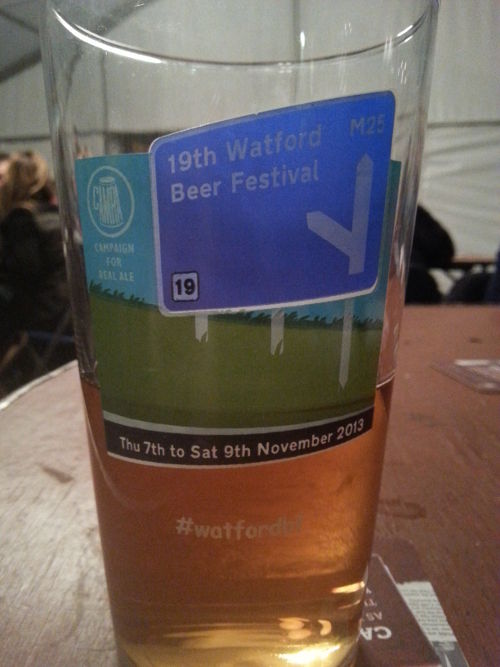
A beer glass from the 19th Watford Beer Festival
With that in mind, it is always a pleasure to attend beer festivals. However, it’s not necessarily a case of ‘bigger is better’. Indeed, sometimes the smaller CAMRA events (the UK Campaign for Real Ale) can be just as enjoyable as the large-scale beer fests and one example of this is Watford’s annual gathering, just north of London. This year, dosed up with paracetemol, I decided to revisit the 3-day Watford Beer Festival, celebrating its 19th year, which took place at the West Herts Sports Club. Going early Saturday evening, I stayed for a few hours with friends, even joining in the free quiz taking place in the marquee outside – an unexpected bonus ending with mid-table respectability!). I had plenty of time to enjoy some of the 60 or so beers available on the day, all served in a choice of third, half or one pint measures.
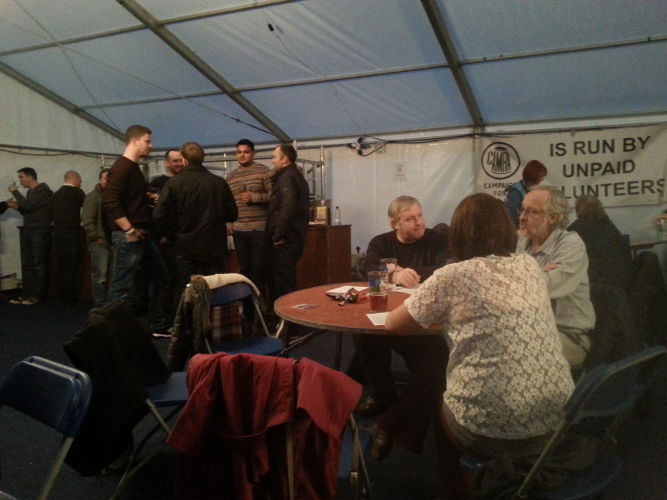
In the marquee outside
The organisers reported attendance figures of 1350 over the 3 days, a very respectable turn-out with Friday being especially busy. As with previous years, the atmosphere is extremely friendly and relaxed with a good choice of beer styles, although I would have preferred a few more milds on the day. Unfortunately, many of the popular choices had run out before I’d had a chance to try them – for example, Elland’s ‘1872 Porter’, Champion Beer of Britain 2013, but that just shows how good the beer is!
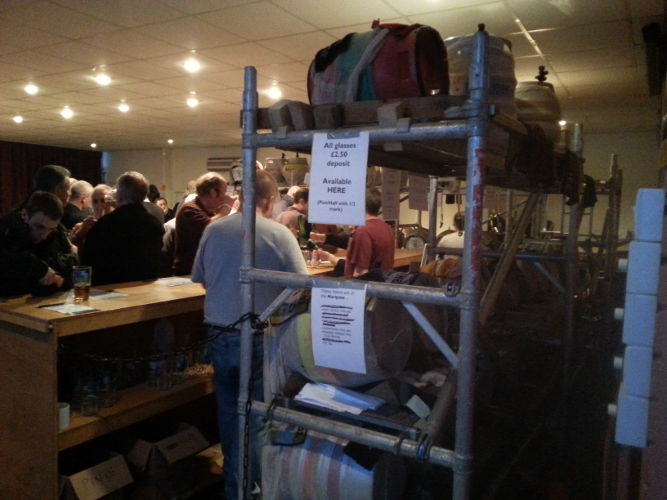
A view from behind the main bar
- Bitter: typically a session beer of around 3.5% ABV, often quite hoppy, usually brown with medium to strong levels of bitterness.
- Best Bitter : generally above 4% ABV, with a stronger malt profile and can, but not always, be more bitter than the above.
- Mild: a traditional style, undergoing a bit of a revival in the UK. Although characterised by a distinctive malty and less hoppy flavour, usually but not exclusively a darker colour and lower alcohol (less than 4% ABV), there are exceptions and subdivisions, such as ‘ruby mild’, ‘strong mild’ and ‘dark mild’.
- Stout: a beer style made with dark roasted malts, which normally impart a black colour and a characteristic roasted malt flavour. Deriving from the 17th/18th century use of ‘stout’ meaning ‘strong’, the term now tends to mean ‘stout’ in body, i.e. dark, full-bodied with dry roast bitterness. However, there are many variations, including ‘sweet stout’, ‘oyster stout’ and the stronger ‘imperial stout’. Normal alcohol levels range between 4 and 8% ABV.
- Porter: often compared to stout, this is a traditional London style emanating from the 1730s. Generally sweeter, heavily malted, black or dark brown in colour and perhaps less aggressively hopped than stouts, there are similarly a number of subdivisions, including ‘brown’, ‘robust’ and ‘Baltic’. From personal experience, I can vouch for some excellent porters from Finland! Typical alcohol levels range from 4 to 6.5% ABV.
- Strong beers: alternative brews of 5% ABV and above.
- Speciality beers: those brewed with more unusual ingredients.
Of course, this does not represent an exclusive list of beer styles, but what is notable is that an increasing number of brewers are experimenting with hops of different origins, i.e. from the U.S., New Zealand, as well as from the UK. This has broadened the variety of styles even further, among both real ales and craft beers, with many brews now showing strong citrus notes, for example, typically from American hops. Responding to consumer demand, modern palates and the desire to be innovative are worthy aims often shared by both craft keg beer and cask ale producers. However, the strong sense of tradition, in terms of beer styles and brewing techniques, e.g. the slow secondary fermentation of real ales, is something that CAMRA strives hard to support. Nevertheless, there is clearly a place for all styles – cask or keg, craft or real – and ultimately, surely what matters most, is that the end product is of good quality.
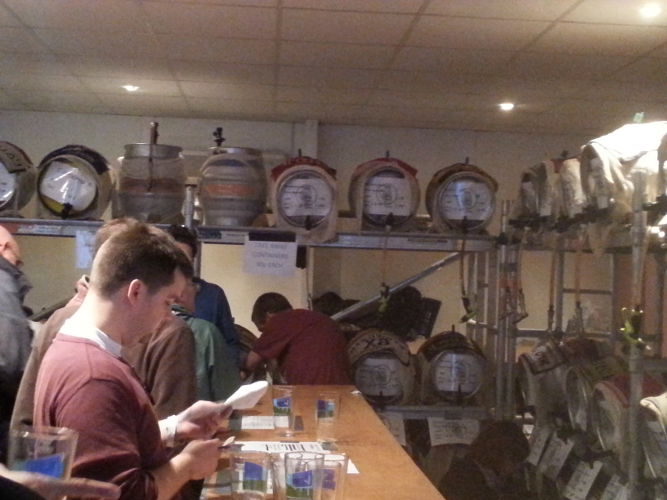
Real ale barrels
Redemption is an award-winning London craft brewery, which began production in 2010. This particular golden amber-coloured cask ale shows subtle hoppy hints, complemented by apple, toffee and citrus notes on the nose, while on the palate, initial citrus, toast and a bitter hop quality lead on to a satisfying grapefruit and orange end-palate.
Joseph Holt’s historic brewery, based in Manchester, has received many accolades over the years, including a Silver at the 2002 Brewing Industry International Awards for its dark amber-coloured mild, made with English cone hops. The nose has dried fruits, dates and molasses with a hint of smoke and a roasted malt character. The palate is refreshingly bitter and extremely smooth, with hints of chocolate, treacle, apples and figs.
Mighty Oak, from Maldon in Essex, is perhaps best known for its Maldon Gold, voted the best Golden Ale in Britain in 2007. Captain Bob is an amber-coloured brew made with Nelson Sauvin hops from New Zealand. The aroma is full of fruit, with notes of ripe orange, apple and toffee, while the palate has similar notes with a touch of almost grape-like sweetness on the finish.
Jarrow, from the North-East of England started brewing in 2002, gaining many awards for several of its beers. Red Ellen, so named in honour of a rebellious parliamentarian of the 1930s, was my favourite beer of the night. A rich ruby red colour, this is extremely fruity with notes of citrus, plums and pears plus a touch of smoke. A full-flavoured palate is completed by a refreshing Campari-like bitter edge on the finish.
In addition to the festival beers, the sports club bar offered a choice of three delights – Buntingford’s Imperial Pale Ale (7.2%), Burton Bridge’s Bramble Stout (5%) and Wells Youngs’ Courage Imperial Russian Stout (10%). Furthermore, there were several ciders available too at the festival, including Gwynt y Ddraig’s award-winning excellent ‘Black Dragon’ cider (7.2%).
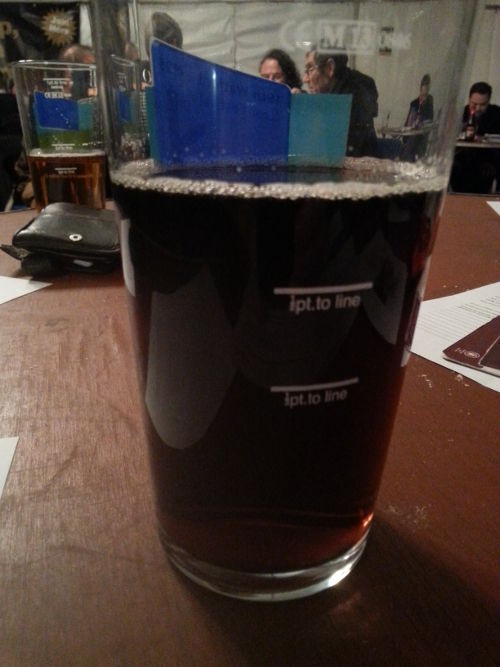
A generous half pint!
The more consumers eschew tasteless, mass-produced beers, in favour of good quality alternatives, whether ‘craft keg’ or ‘cask real’, the better for all concerned. I, for one, see craft beer’s emergence and popularity as a positive opportunity for CAMRA to showcase the variety of real ale styles to a wider audience. Sticking to its founding principles and key campaigns, e.g. encouraging "more people to try a range of real ales, cider and perries", the organisation can successfully respond to and embrace a modern audience. After all, in order to survive long-term, CAMRA must never lose its relevance as a consumer body in the modern age.
Despite continuing pub closures amid times of financial austerity, the astonishing growth of microbreweries (especially in London) and CAMRA’s own membership figures now exceeding 150,000, provide clear reasons for optimism regarding the future of beer in all its guises. I look forward to many years of excellent choice and quality. Cheers!
A further discussion of real ale vs craft can be found in my blog post from January 2013.
